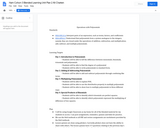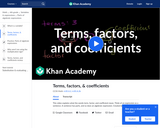
Students use the commutative and associative properties to recognize structure within expressions and to prove equivalency of expressions.
- Subject:
- Math 1
- Mathematics
- Material Type:
- Lesson
- Author:
- Engage NY
- Date Added:
- 01/31/2020

Students use the commutative and associative properties to recognize structure within expressions and to prove equivalency of expressions.

Students understand that factoring reverses the multiplication process as they find the linear factors of basic, factorable quadratic trinomials.
Students explore squaring a binomial, factoring the difference of squares, and finding the product of a sum and difference of the same two terms.

Students solve increasingly complex one-variable equations, some of which need algebraic manipulation, including factoring as a first step and using the zero product property.

Students graph simple quadratic equations of the form y = a(x - h)2 + k (completed-square or vertex form), recognizing that (h,k) represents the vertex of the graph and use a graph to construct a quadratic equation in vertex form.
Students understand the relationship between the leading coefficient of a quadratic function and its concavity and slope and recognize that an infinite number of quadratic functions share the same vertex.

CK-12 Foundation's Algebra FlexBook is an introduction to algebraic concepts for the high school student. Topics include: Equations & Functions, Real Numbers, Equations of Lines, Solving Systems of Equations & Quadratic Equations.

Eight task cards that are self-checking on classifying polynomials.

Article with practice on identifying exponential growth and decay examples.

Unit on identifying parts of linear equations

In exponential functions the variable is in the exponent, like y=3^x. This video introduces this concept with a few examples.

This is the first task of two that focus on understanding and using various notations for linear
functions. The task involves students in thinking about a context where students have selected the
index in two different ways, thus getting two different, but equivalent equations. The idea is
extended so that students can see the relationship expressed in point/slope form of the equation of
the line.

As students prepare to work with algebraic expressions, either with operations (add, subtract, multiply, or divide) or when making connections to constant, linear, and/or quadratic functions, it is important that students can name basic polynomial expressions as monomials, binomials, or trinomials, During this activity students will learn how to name these polynomials through watching a video, practice naming polynomials through a sorting activity, and then complete five-formative assessment questions.

Learning what polynomials are, how to add, subtract and multiply them.

Students will continue to interpret expressions, create equations, rewrite equations and functions in different but equivalent forms, and graph and interpret functions, but this time using polynomial functions, and more specifically quadratic functions, as well as square root and cube root functions.

This video explains what the words term, factor, and coefficient mean. Think of an expression as a sentence. A sentence has parts, and so does an algebraic expression.

Students will understand what effects the coefficients a, b, and c have on the graph of a standard quadratic equation of the form y=ax^2 +bx+c.